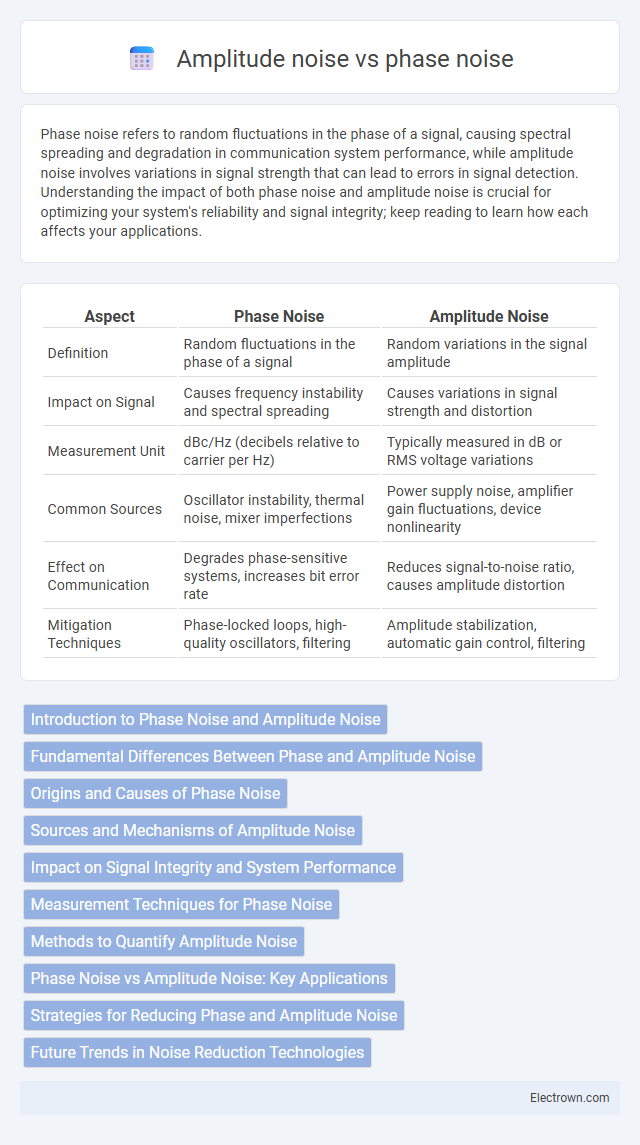Phase noise refers to random fluctuations in the phase of a signal, causing spectral spreading and degradation in communication system performance, while amplitude noise involves variations in signal strength that can lead to errors in signal detection. Understanding the impact of both phase noise and amplitude noise is crucial for optimizing your system's reliability and signal integrity; keep reading to learn how each affects your applications.
Table of Comparison
| Aspect | Phase Noise | Amplitude Noise |
|---|---|---|
| Definition | Random fluctuations in the phase of a signal | Random variations in the signal amplitude |
| Impact on Signal | Causes frequency instability and spectral spreading | Causes variations in signal strength and distortion |
| Measurement Unit | dBc/Hz (decibels relative to carrier per Hz) | Typically measured in dB or RMS voltage variations |
| Common Sources | Oscillator instability, thermal noise, mixer imperfections | Power supply noise, amplifier gain fluctuations, device nonlinearity |
| Effect on Communication | Degrades phase-sensitive systems, increases bit error rate | Reduces signal-to-noise ratio, causes amplitude distortion |
| Mitigation Techniques | Phase-locked loops, high-quality oscillators, filtering | Amplitude stabilization, automatic gain control, filtering |
Introduction to Phase Noise and Amplitude Noise
Phase noise refers to rapid, short-term fluctuations in the phase of a signal, which degrade the signal's spectral purity and cause frequency jitter in oscillators and communication systems. Amplitude noise involves variations in the signal's amplitude, leading to changes in signal strength and impacting signal-to-noise ratio (SNR) and overall system performance. Understanding the distinct impacts of phase noise and amplitude noise is critical for designing high-precision frequency sources and maintaining signal integrity in RF and microwave applications.
Fundamental Differences Between Phase and Amplitude Noise
Phase noise refers to rapid, short-term fluctuations in the phase of a signal, causing frequency instability and spectral spreading, while amplitude noise pertains to variations in signal strength or power that impact the signal's voltage or current levels. The fundamental difference lies in the way these noises affect signal characteristics: phase noise alters the timing and frequency domain, leading to jitter and signal distortion, whereas amplitude noise affects signal magnitude, leading to variations in signal power and potential bit errors. Understanding these distinctions helps you optimize communication system performance by mitigating the specific type of noise most detrimental to your application's signal integrity.
Origins and Causes of Phase Noise
Phase noise originates primarily from the inherent fluctuations in the frequency of an oscillator caused by electronic components' thermal noise, flicker noise, and device imperfections. These fluctuations manifest as rapid, random variations in the phase of the signal, leading to spectral spreading around the carrier frequency. Understanding the physical sources of phase noise enables you to design more stable oscillators and improve the performance of communication systems by minimizing signal distortion.
Sources and Mechanisms of Amplitude Noise
Amplitude noise originates from fluctuations in the signal's power level caused by factors such as thermal noise, shot noise, and flicker noise within active electronic components like transistors and amplifiers. External interference from power supply variations and electromagnetic coupling also contributes to amplitude noise by modulating the signal amplitude unpredictably. Your design must address these sources through careful component selection and shielding to minimize amplitude noise impact on overall system performance.
Impact on Signal Integrity and System Performance
Phase noise primarily affects signal integrity by causing timing jitter and frequency instability, leading to degraded system performance in communication links and radar systems. Amplitude noise influences signal amplitude variations, resulting in errors in signal detection and reduced signal-to-noise ratio, which directly impacts data accuracy and reliability. Minimizing both phase noise and amplitude noise is crucial for maintaining high-fidelity signals and ensuring optimal system performance in sensitive electronic applications.
Measurement Techniques for Phase Noise
Phase noise measurement techniques primarily involve the use of spectrum analyzers equipped with phase noise measurement capabilities or dedicated phase noise analyzers that employ cross-correlation methods to improve sensitivity. The delay line discriminator method is another common approach, where the frequency fluctuations are converted into voltage variations for analysis. Accurate phase noise characterization requires low-noise reference oscillators and careful calibration to minimize measurement system contributions.
Methods to Quantify Amplitude Noise
Amplitude noise is commonly quantified using metrics such as the root mean square (RMS) value and the amplitude modulation (AM) noise spectral density. Techniques like vector signal analyzers and spectrum analyzers with AM demodulation are employed to accurately measure the amplitude noise components in electronic signals. Your analysis may benefit from employing Allan variance or power spectral density methods to gain deeper insight into the amplitude noise behavior over time.
Phase Noise vs Amplitude Noise: Key Applications
Phase noise and amplitude noise impact signal integrity differently in key applications such as wireless communications, radar systems, and precision measurement. Phase noise primarily affects the spectral purity and timing accuracy, crucial for coherent detection and frequency synthesis. Your system performance depends on minimizing amplitude noise to maintain signal strength and reduce distortion in analog and digital circuit designs.
Strategies for Reducing Phase and Amplitude Noise
Effective strategies for reducing phase noise include improving oscillator design with low-noise components, implementing phase-locked loops (PLLs) for stabilization, and utilizing high-quality power supplies to minimize fluctuations. Amplitude noise can be mitigated by employing automatic gain control (AGC) circuits, using low-noise amplifiers, and maintaining consistent signal amplitude through careful shielding and filtering techniques. Your system's overall performance benefits significantly by combining these approaches to address both phase and amplitude noise concurrently.
Future Trends in Noise Reduction Technologies
Future trends in noise reduction technologies emphasize advanced digital signal processing and machine learning algorithms to minimize phase noise and amplitude noise in electronic systems. Innovations in ultra-low noise oscillators and high-precision components aim to enhance signal clarity and stability for applications in 5G, quantum computing, and radar systems. Your devices will benefit from improved noise suppression techniques that increase reliability and performance in increasingly complex communication environments.
Phase noise vs amplitude noise Infographic

 electrown.com
electrown.com